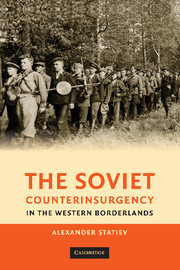Book contents
- Frontmatter
- Contents
- List of Figures
- List of Tables
- Acknowledgments
- Glossary
- Introduction
- 1 Origins of Soviet Counterinsurgency
- 2 The Borderland Societies in the Interwar Period: The First Soviet Occupation and the Emergence of Nationalist Resistance
- 3 The Borderlands under German Occupation (1941–1944): Social Context of the Soviet Reconquest
- 4 Nationalist Resistance after the Soviet Reconquest
- 5 Soviet Agrarian Policy as a Pacification Tool
- 6 Deportations, “Repatriations,” and Other Types of Forced Migration as Aspects of Security Policy
- 7 Amnesties
- 8 Red Rurales: The Destruction Battalions
- 9 Police Tactics: Actions of NKVD Security Units, Intelligence Gathering, Covert Operations, and Intimidation
- 10 The Church in Soviet Security Policy
- 11 Violations of Official Policy and Their Impact on Pacification
- 12 Conclusion: Nationalist Resistance and Soviet Counterinsurgency in the Global Context
- Appendix A Note on Used Terms and Geographic and Personal Names
- Appendix B Note on Primary Sources
- Bibliography
- Index
9 - Police Tactics: Actions of NKVD Security Units, Intelligence Gathering, Covert Operations, and Intimidation
Published online by Cambridge University Press: 05 May 2010
- Frontmatter
- Contents
- List of Figures
- List of Tables
- Acknowledgments
- Glossary
- Introduction
- 1 Origins of Soviet Counterinsurgency
- 2 The Borderland Societies in the Interwar Period: The First Soviet Occupation and the Emergence of Nationalist Resistance
- 3 The Borderlands under German Occupation (1941–1944): Social Context of the Soviet Reconquest
- 4 Nationalist Resistance after the Soviet Reconquest
- 5 Soviet Agrarian Policy as a Pacification Tool
- 6 Deportations, “Repatriations,” and Other Types of Forced Migration as Aspects of Security Policy
- 7 Amnesties
- 8 Red Rurales: The Destruction Battalions
- 9 Police Tactics: Actions of NKVD Security Units, Intelligence Gathering, Covert Operations, and Intimidation
- 10 The Church in Soviet Security Policy
- 11 Violations of Official Policy and Their Impact on Pacification
- 12 Conclusion: Nationalist Resistance and Soviet Counterinsurgency in the Global Context
- Appendix A Note on Used Terms and Geographic and Personal Names
- Appendix B Note on Primary Sources
- Bibliography
- Index
Summary
Razvedka nasha–ves' narod! [Our intelligence service is our entire nation!]
– Song about Nikolai Ezhov, head of the NKVD in 1936–1938This study focuses on Soviet counterinsurgency strategy. However, it would be incomplete without a brief overview of the tactical tools the security agencies employed to suppress resistance. Counterinsurgents rejecting indiscriminate repressions face three major challenges: They have to spot permanently operating guerrilla bands, separate part-time rebels from civilians, and identify insurgent infrastructure. When these tasks are solved, the military superiority of regular forces makes the destruction of guerrillas easy. Intelligence is vital for the success of counterinsurgency. In rural regions with well-entrenched rebellion, police are usually overstretched and have insufficient manpower to maintain permanent surveillance over suspects. Instead, they receive intelligence from informers, undercover agents, and suspects whom they interrogate. In addition to intelligence acquisition, agents perform a variety of other missions: They assassinate rebel leaders, undermine the morale of rank and file, discredit guerrillas among their comrades and civilians, and help the police in eradicating treason within their structures. Meanwhile, the security forces raid guerrilla bases pinpointed by their agents, arrest members of the insurgent infrastructure identified by informers, and intimidate civilian sympathizers of the resistance into neutrality. The Soviet police employed all these methods with some sophistication, considerable flexibility, and extreme ruthlessness, seeking to focus the repressions on enemies of the regime while sparing apathetic, even unfriendly, “class allies” – the rural majority.
- Type
- Chapter
- Information
- The Soviet Counterinsurgency in the Western Borderlands , pp. 230 - 252Publisher: Cambridge University PressPrint publication year: 2010



